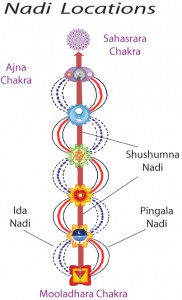What I don’t mean by Kundalini Yoga
When you hear the term Kundalini Yoga, you may think of the white turbans of Yogi Bhajan and his 3HO. As it happens with many yogic and Sanskrit words, Kundalini is a very old concept that is today almost exclusively associated with the movement that first (or most) popularized it. Yogi Bhajan’s is merely one interpretation of Kundalini Yoga, and a very recent one at that: Kundalini Yoga was first mentioned in the Upanishads around 500BC, Yogi Bhajan’s version dates from 1968.
Born to a Sikh father and a Hindu mother, Yogi Bhajan took the teachings of his yoga guru, Swami Dhirendra Brahmachari, and amalgamated them with the Sikh doctrines of his spiritual leader, Maharaj Virsa Singh. So one could say that Yogi Bhajan’s yoga is a marriage between the Hindu and Sikh traditions (hence the turbans). He wasn’t the first to introduce Kundalini to the West (John Woodroffe did that in the 1910s), but he was the first to remove the secrecy that had surrounded these practices since the dawn of time. He was also extremely successful at spreading his teachings through his controversial Healthy, Happy and Holy Organization (3HO).
Kundalini Yoga has been closely associated to many yoga traditions for centuries, and is a fundamental aspect of Tantra.
What I mean by Kundalini Yoga
According to the tradition in which I was educated; the Tantra of Swami Satyananda, Swami Sivananda, and their teachers all the way to Adi Shankaracharya in the 8th Century; Kundalini Yoga is the science of awakening powerful dormant energies in our body.
Yoga understands man as a group of five interconnected layers, each more subtle than the previous. They are the containers of our true self. These layers are:
1. The Physical Layer
2. The Energy Layer
3. The Mental Layer
4. The Wisdom Layer
5. The Bliss Layer
The physical layer is what we know as the body. The mental layer includes our automatic thoughts and feelings, as well as the experiencing of our senses and our instinctive impulses. The Wisdom Layer, also known as the higher mind, contains our intuition and intellect, our capacity for judgment and our awareness. The bliss layer is thus called because it is experienced as a permanent state of spiritual bliss; a consciousness of completeness.
And what about the energy layer? This is the realm of a subtle life force that animates our whole body. Eastern models of man agree that the body is permeated by energy channels (called Nadis in Yoga, and meridians in Chinese medicine). The energy that flows through these subtle channels, the Qi of Qi-Gong, the Chi of Thai Chi, the Prana of Pranayama, is the stuff that Kundalini is made off.
subtle life force that animates our whole body. Eastern models of man agree that the body is permeated by energy channels (called Nadis in Yoga, and meridians in Chinese medicine). The energy that flows through these subtle channels, the Qi of Qi-Gong, the Chi of Thai Chi, the Prana of Pranayama, is the stuff that Kundalini is made off.
In the yogic model, it is said that there are thousands of channels moving prana through the body. Of these, three are most important: Sushumna, which runs along the spine, from the perineum to the crown of the head; and Ida and Pingala, which run in a weave alongside Sushumna. Ida and Pingala cross Sushumna at several points, at each of which we find one of the major chakras (see image).
So what is Kundalini? It is a latent energy that resides at the root of Sushumna, in the location of Mooladhara chakra. This energy can be awakened and made to ascent along the main nadi, lighting up our chakras like a Christmas tree. This event, known as Kundalini awakening, activates currently silent parts of our brain and our energy body, endowing us with all sorts of fantastic powers and abilities. This is the goal of Kundalini yoga.
Before we awaken Kundalini though, we must first purify the nadis, then awaken the chakras, and finally prepare Sushumna for the passage of this energy. This is a process that takes years, even decades, but along the way one reaps the many benefits of this sort of practice.
With only a few months of practicing the Kundalini techniques, one starts becoming aware of the prana flowing through the body. This awareness increases our perception of self, allowing us to be more conscious of our posture, our mental fluctuations, and even our normally unconscious radiation. Working with the chakras quietly develops abilities that we never thought we could cultivate, like our intuition, our receptivity and our ability to communicate beyond the words we use.
Personally, I don’t care about raising my Kundalini this year, but I have found in the practice of Tantric Kundalini yoga a ready tool to live a more plentiful and satisfying life. Furthermore, the methods of this ancient science can be used for all sorts of therapeutic and practical reasons, or simply to get more energy (stamina) and mental strength.
In his Classical Yoga lessons at English Yoga Berlin, Pedro teaches many of the Tantric Kundalini methods, such as Shambhavi Mudra, Agnisara Kriya, and various powerful pranayama techniques .





